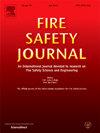Modelling the thermal response of steelwork penetrating a fire-rated compartment wall
IF 3.4
3区 工程技术
Q2 ENGINEERING, CIVIL
引用次数: 0
Abstract
Steelwork penetrating through fire-rated compartment walls can sometimes pose a challenge to ensuring the adequacy of compartment lines. This study investigates the thermal performance of steel beams penetrating fire-rated compartment walls, focusing on heat transfer mechanisms and their implications for insulation criteria. Using Finite Element Modelling, the research evaluates protected and unprotected steel beams in various wall types, including masonry, mass timber, and plasterboard-lined light steel stud wall. The penetration through solid walls, such as brick or mass timber, exhibits similar thermal behaviour, with the required fire protection length primarily dependent on the section factor of the steel rather than wall thickness. Notably, steel beams with a section factor above 150 m−1 require consistent protection lengths across different solid wall materials. In contrast, plasterboard-lined light steel stud walls introduce greater complexity due to additional variables, such as cavity width and plasterboard configuration, influencing the temperature profile of the steel beam. The study highlights the inverse relationship between the section factor and the length of the steel exceeding insulation criteria, emphasizing the need for tailored fire protection strategies. These findings provide critical insights for improving fire safety in designs involving steel penetrations and underscore the necessity of case-specific analysis to ensure compliance with fire resistance requirements.
钢结构穿透防火隔墙的热响应模拟
钢结构穿透防火舱壁有时会对确保舱线的充分性提出挑战。本研究探讨了钢梁穿透防火隔墙的热性能,重点关注传热机制及其对隔热标准的影响。利用有限元模型,研究评估了各种类型的保护和未保护的钢梁,包括砖石、大质量木材和石膏板内衬轻钢钉墙。穿透实心墙体,如砖或大块木材,表现出类似的热行为,所需的防火长度主要取决于钢材的截面系数,而不是壁厚。值得注意的是,截面系数大于150 m−1的钢梁需要在不同的实体墙材料之间保持一致的保护长度。相比之下,石膏板衬砌的轻钢螺柱墙由于其他变量(如腔宽度和石膏板配置)会影响钢梁的温度分布,从而引入了更大的复杂性。该研究强调了截面系数与超过绝缘标准的钢材长度之间的反比关系,强调了定制消防策略的必要性。这些发现为提高涉及钢结构穿透的设计的防火安全性提供了重要见解,并强调了具体案例分析的必要性,以确保符合防火要求。
本文章由计算机程序翻译,如有差异,请以英文原文为准。
求助全文
约1分钟内获得全文
求助全文
来源期刊

Fire Safety Journal
工程技术-材料科学:综合
CiteScore
5.70
自引率
9.70%
发文量
153
审稿时长
60 days
期刊介绍:
Fire Safety Journal is the leading publication dealing with all aspects of fire safety engineering. Its scope is purposefully wide, as it is deemed important to encourage papers from all sources within this multidisciplinary subject, thus providing a forum for its further development as a distinct engineering discipline. This is an essential step towards gaining a status equal to that enjoyed by the other engineering disciplines.
 求助内容:
求助内容: 应助结果提醒方式:
应助结果提醒方式:


